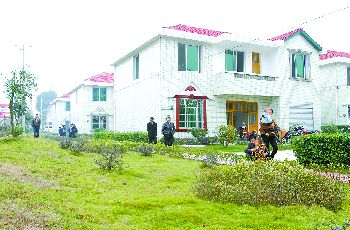 Low-carbon urbanization is the inherent requirement of the new urbanization approach put forward by China under the guidance of the scientific development concept in the new era. Both the Party’s dictatorship and the Central Economic Conference held in December last year required efforts to improve the quality of urbanization. At present, the driving force for the development of urbanization mainly includes two factors: one is the full realization of modernization; the other is the expansion of domestic demand.
Low-carbon urbanization is the inherent requirement of the new urbanization approach put forward by China under the guidance of the scientific development concept in the new era. Both the Party’s dictatorship and the Central Economic Conference held in December last year required efforts to improve the quality of urbanization. At present, the driving force for the development of urbanization mainly includes two factors: one is the full realization of modernization; the other is the expansion of domestic demand. The road to low-carbon energy development is to use advanced science and technology to reduce energy consumption and save energy, increase the proportion of green and clean renewable energy resources, change the extensive and backward energy utilization methods, and gradually reduce the proportion of fossil energy use. The process of achieving low carbonization is both a modern process and a means to expand domestic demand.
The low-carbon energy road is an important guarantee for ensuring the quality of urbanization. Energy is the material basis for the operation of cities. The city is a concentrated living area for human beings and also an intensive energy consumption area. The quality of urbanization depends on whether or not to fully integrate the concepts and principles of ecological civilization into the entire process of urbanization. The traditional urbanization development road has a large energy consumption intensity, serious environmental pollution, and high dependence on external energy sources. The low-carbon energy road is a reform of energy consumption and production methods, reducing energy consumption intensity and total energy consumption, making full use of local renewable energy sources to meet local energy consumption, alleviating the shortage of energy supply in cities, and building a beautiful environment. Urban environment.
The low-carbon energy road will help China achieve its goal of reducing carbon dioxide emissions per unit of gross domestic product by 2020. The infrastructure construction and housing construction in the process of urbanization are huge, the total energy consumption is large, and the potential for energy conservation is also great. Industrial energy consumption is China's largest energy-consuming sector, and industrial facilities are generally located in cities. Therefore, the city's low-carbon energy road is the focus of energy conservation efforts. The energy consumption of urban buildings and transportation also occupies a large proportion of energy consumption, and has broad potential for energy conservation. The road to urbanization of low-carbon energy also provides a broad market for the development of renewable energy.
The realization of urbanization of low-carbon energy requires scientific design in terms of urban planning concepts and policy mechanisms. To take the low-carbon energy road needs to consider the following questions: First, a scientific and rational city layout. To realize the low-carbon energy road, we must fully integrate the urban layout with the characteristics of low-carbon energy. Renewable energy is an important means of low-carbon energy, but the resource density of renewable energy is low, and the energy supply capacity per unit area is relatively weaker than traditional fossil energy. Therefore, urban residential houses and industrial facilities powered by renewable energy are not Suitably large-scale, it should be developed in accordance with the mode of small towns, and fully consider the matching degree between renewable energy supply capacity and urban energy use. In addition, the characteristics of the distribution of renewable energy sources and the combination of different renewable energy utilization methods all need to be based on the characteristics of the renewable energy resources in the city's area, such as wind power, solar energy and geothermal energy combined heating and cooling.
The second is the concept of circular economy development. The development of a circular economy will help reduce the use of resources and reduce waste emissions. The government should strengthen the propaganda and education of circular economy, promote ecological values ​​and green consumption, and minimize waste discharge.
The third is a strong renewable energy use policy. Establish investment, subsidy, operation, management and supervision mechanisms that encourage the application of renewable energy in the process of urbanization. Under current technological conditions, most of the renewable energy applications are relatively poor in terms of technology and economy, and certain incentive measures need to be taken to increase the enthusiasm for investing in the use of renewable energy in the process of urbanization. In addition, the use of low-temperature solar energy in solar energy has certain economic benefits, and it is suitable for large-scale promotion. Coercive measures should be formulated to promote the use of solar energy and low-temperature technologies in public buildings, residential houses, and suitable industrial fields.
Ultraviolet Lamp,Pls Uvc Light,Pls Uvc Bulb,Pls Uvc Tube
Changxing leboom lighting product CO.Ltd. , https://www.leboomuvd.com